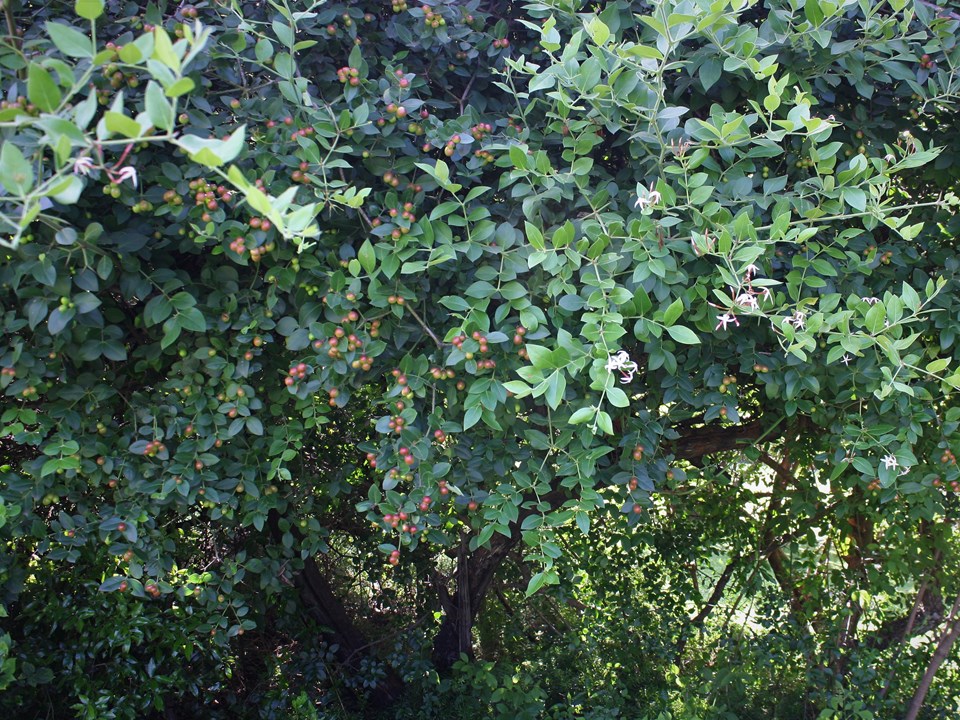Carissa edulis

|
|
Carissa edulis Common Names: Carrisse, Carandas, Conkerberry, Arabic
Num-Num Scientific
Classification Kingdom: Plantae Phylum: Tracheophyta Class: Magnoliopsida Order: Gentianales Family: Apocynaceae Genus: Carissa Species: C. edulis Synonyms: Arduina edulis (Vahl) Spreng., Carissa bispinosa var. edulis (Vahl) A.DC., Jasminonerium edule (Vahl) Kuntze, Vahl ex DC. Morphological Description Carissa edulis,
commonly known as Carrisse or Conkerberry, is a spiny, evergreen shrub or small
tree, typically growing 2–6 m tall, occasionally reaching 10 m in fertile
soils. Its key features include: · Stem: Young branches green, glabrous or pubescent, maturing to
light brown with fissured, corky bark; armed with rigid, straight spines up to
7 cm long · Leaves: Simple, opposite, ovate to elliptic, 2–7 cm long, 1–4 cm
wide, leathery, dark green above, paler below, with entire margins and a
petiole up to 5 mm long · Flowers: White to pinkish-purple, fragrant, 1–2 cm in diameter, in
terminal or axillary cymes up to 4 cm wide, with 5 petals and a tubular corolla · Fruit: Ovoid berries, 6–11 mm long, red ripening to purplish-black,
fleshy, sweet, containing 2–4 flat seeds The plant exudes a
white, non-toxic milky latex when cut, and its edible fruit and extensive medicinal
uses make it a valuable species in African ethnobotany (Fern, 2024; Al-Youssef
& Hassan, 2017). Distribution and Habitat Carissa edulis is
native to a broad region of Africa, spanning from South Africa to Ethiopia,
Senegal, and Somalia, with extensions into the Arabian Peninsula (Yemen, Saudi
Arabia). It thrives in diverse habitats: · Ecosystems: Savanna woodlands, bushlands, grasslands, coastal scrub,
riverine thickets, and rocky hillsides · Climate: Tropical to subtropical, with annual rainfall of 400–2,000
mm and temperatures of 15–35°C · Soils: Well-drained, sandy to loamy, tolerating rocky, saline, or
nutrient-poor conditions · Altitude: Sea level to 2,700 m In Nigeria, it is
prevalent in northern states like Kano and Borno, as well as southern regions,
often found in disturbed areas, along forest edges, or cultivated as a hedge
plant due to its spiny nature. Ethnopharmacology Carissa edulis ,
commonly known as simple-spined num-num or wild karanda, is a valuable
medicinal plant traditionally used across Africa and parts of Asia. Different
parts of the plant, particularly the roots, leaves, bark, and fruits, possess
antimicrobial, anti-inflammatory, antioxidant, analgesic, antimalarial,
antidiabetic, and diuretic properties. In traditional medicine, root decoctions
are commonly used to treat fevers, malaria, headaches, rheumatism, and
gastrointestinal disorders, while leaf extracts are applied to manage coughs,
chest pains, and wound infections. The fruits are also consumed for their
nutritional and digestive benefits. Phytochemical investigations have revealed
the presence of flavonoids, tannins, saponins, alkaloids, and terpenoids, which
contribute to the plant’s wide range of therapeutic effects. While Carissa
edulis is widely utilized in folk medicine, more scientific research and
clinical trials are needed to fully substantiate its medicinal claims and
determine standardized safe doses. · Anticonvulsant Properties: Aqueous
root bark extracts (50 mg/kg) delayed pentylenetetrazole-induced seizures in
mice by 60%, validating their use for epilepsy management in Nigeria. The
effect is linked to lignans like carissanol (Ya’u et al., 2008). · Anti-inflammatory Effects: Ethanolic
root extracts (200 mg/kg) reduced carrageenan-induced paw edema in rats by 45%
after 3 hours, attributed to β-amyrin and quercetin, validating use for
rheumatism and inflammation in Nigeria (Woode et al., 2008). · Antidiabetic Potential: Aqueous
leaf extracts (400 mg/kg) lowered blood glucose by 30% in alloxan-induced
diabetic rats after 4 weeks, validating their use for diabetes in Yemen and
Nigeria (El-Fiky et al., 1996). · Antiviral Activity: Methanolic
root extracts (50 µg/mL) inhibited herpes simplex virus (HSV) plaque formation
by 70% in vitro, validating use for skin infections in Kenya (Tolo et al.,
2006). · Anticancer Potential: Leaf
extracts containing carissaeduloside J exhibited cytotoxicity against leukemia
cell lines (IC₅₀ 0.029 µM) in vitro, supporting potential anticancer therapy in
Nigeria (Kaunda & Zhang, 2017). · Neuroprotective Effects: Aqueous
leaf extracts (200 mg/kg) improved memory retention by 40% in
scopolamine-induced amnesia in mice, validating use for cognitive disorders in
Cameroon (Fanta et al., 2021). ⚠ Toxicity Profile: Carissa edulis exhibits low acute oral toxicity (LD₅₀ >5,000 mg/kg
in rats), with no significant adverse effects at doses below 1,000 mg/kg in
28-day rat studies. Sub-chronic administration at 600 mg/kg caused mild
elevations in liver enzymes (ALT, AST) and altered lipid profiles, indicating
potential hepatotoxicity. High doses of root extracts (1,200 mg/kg) showed
nephrotoxicity in rats, with elevated creatinine levels. The milky latex may
cause contact dermatitis in sensitive individuals. Its traditional use as an abortifacient
suggests embryotoxicity, necessitating caution during pregnancy. Boiled
preparations reduce risks, but prolonged or high-dose use should be avoided
(Ya’u et al., 2013; Kaunda & Zhang, 2017). Additional Uses · Culinary: Ripe fruits are sweet and edible, consumed fresh or
processed into jams, jellies, or beverages in Nigeria and South Africa. · Ecological Role: Spiny branches form natural hedges,
deterring livestock and stabilizing soils in savanna ecosystems in Nigeria and
Kenya. · Agricultural: Leaf extracts serve as natural insecticides against pests
like Aedes aegypti in
Nigeria, leveraging terpenoids such as carissone. References
External Links More Pictures |
|
| Compounds of Carissa edulis | |
| References |